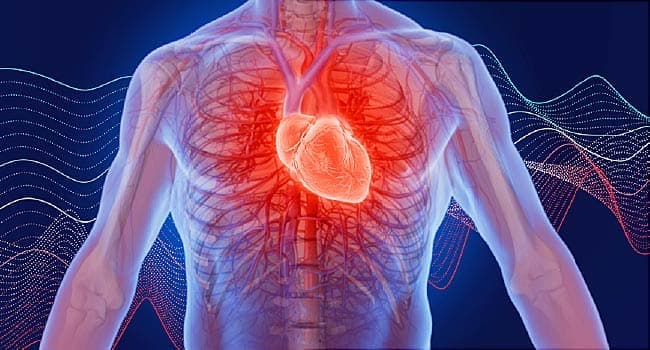You cross the finish line, or maybe you’re almost there when your fitness app tells you to cool off. Except for the sound of a drum in your chest, everything seems to be calm. Even though you slow down and your breathing is quiet, the thump sounds more intense. A lot of runners ignore it. The fear of what might go wrong is a tingling sense. That can set off a whole chain of events.
This worry spike is human. It’s one of the traditional physical manifestations caused by anxiety that can transform the normal heartbeat into a warning alarm. Being aware of the distinction between a strong but healthy heart and a legitimate alarm signal is essential to transforming anxiety into confidence within the first few minutes following every run.
Heartbeat Explained: What Causes That After-Stop Thump-Thump?
In rest, your heart closes its valves using the familiar Lub-dub rhythm. While you are running, the pump accelerates to high speed creating greater beats in a minute. It also produces more force per beat, and larger blood vessels that speed up oxygen supply to your muscles. If you stop abruptly, the muscles don’t require the flow of oxygen, but blood is still flowing through these dilated blood vessels. For 30-60 minutes, your heart will continue to beat due to the arteries’ pressure sensors require a few seconds to verify that the workload has reduced.
In the “settling” phase, every other sound that you hear is quiet and allows the pulse waves that travel through your arteries neck to travel to your eardrums in a completely unhindered manner. It’s like having an eardrum that is ringing however your cardiovascular system functions exactly how it is designed. In healthy adults, your heart rate is expected to decrease gradually, around 10-20 beats per minute during every minute of walking until it returns to a normal speed.
The First 60 Seconds: Inside Your Body’s Transition
Imagine a city’s primary roundabout that changes suddenly to an intersection with four lanes. The traffic (blood) continues to flow fast however the demand (oxygen intake) has slowed, and the pressure has dropped. The brain responds by requesting to make a few more powerful beats to maintain the flow. Agonist hormones remain in circulation and your vessels remain somewhat open before narrowing towards the width of rest. This chain reaction is the reason for the short pounding and a tinny “whoosh” in your ears or a flutter that may refer to as a palpitation. is referred to as liven.
So long as the feeling disappears in a predictable manner and isn’t followed with a crushing ache dizziness, numbness, or extreme breath shortness It’s considered to be normal recovery. Professional athletes are aware of it, and first-time joggers are aware of it. It’s the sound of your heart’s thumping out of the fuel.
Quieting the Storm: Quick Calm-Down Techniques
A three-to-five-minute stroll is still the most effective method of telling your heart that the race is over. Each step stretches the huge veins that run through your calves, bringing blood upwards so that it doesn’t clog your legs and make you feeling woozy. Incorporate a slow breathing routine over it: breathe with your mouth for four times and hold for a few seconds and exhale with lips that are pursed for more than twice the time. The extended breath stimulates the vagus nerve and pushes your nervous system away from “fight or flight” toward “rest and digest.”
If you feel tension in your shoulders or chest, try rolling your shoulder blades downwards and backwards while you walk. The simple change in posture can open lung space, stretches every breath after, then then subtly signalizes the brain that the work is over. Many athletes swear by cooling down playlist with tracks that are set at about 70-90 beats a minute. Many say that our heart rate tends shift towards the predominant rhythm that we hear, so play the soft beats of acoustic music or even lo-fi and allow the music to help you recover.
Physical Symptoms of Anxiety or Normal Recovery?
Post-run adrenaline is a hormone that can resemble anxiety in such a way that distancing the two can be difficult. The feeling of shaking hands, palpitations and a tingle on your face, even mild chest pressure result from the same surge of hormones.
Context is the best friend you can have. The sensations that occur only when you stop can be a blur when adrenaline has gone away. Any discomfort that is felt in the middle of a run, particularly in the event that it becomes worse as you exert yourself is worthy of professional focus.
Everyone who runs can create an individual evidence log. After every run, record the time of completion, the highest heart rate and recovery heart rate at the 3-minute mark, as well as any sensations you experienced. Patterns emerge quickly. If anxiety attempts to take over the next cooling down and you’ll be able to gather evidence that shows loud is not as being dangerous.
When to Seek Help: Know Your Red Flags
Even the most skilled athlete must treat certain symptoms as non-negotiable warnings. Make sure to stop immediately and seek medical attention if you experience discomfort in your chest that is pulsating or radiating and your heart rate does not lower below 120 beats a minute after a rest period of 10 minutes or if you notice an abrupt shortness of breath, that is accompanied by a grayish skin, cold sweat as well as fainting or blurred vision. Doctors would prefer to comfort the ten runners with apprehension instead of treating someone who has was waiting too long. So, take your time whenever you feel something is not in line with your body.
Building a Long-Term Calm-Down Routine
Consistency beats complexity. Pick a specific breathing pattern, a brief walk, and a mental cue, such as repeating a mantra, or focusing upon the line of the horizon. Repeat the exercise every time you run until your brain connects with the “finish line” with “easy landing.”
After a couple of weeks, the mere beginning of your routine turns into a security signal that reduces adrenaline levels and easing heart rate recovery and giving you a better perception about what your everyday life is like. With your confidence in place in your pocket, the rumbling of your heart goes from a threat to proudly remembrance of how well you did your job.
Conclusion
The heartbeat that the moment the last run isn’t a siren. The sound is that of a high-performance pump coming back into its top speed. If you are familiar with the fundamentals of blood flow physics, you can practice cooling down in a short amount, and watch out for any red flags that are genuine and you can move from anxiety to peace in just a few just a few seconds. Allow your heart to beat safely and always remember that A strong heartbeat that is able to settle smoothly is almost always a sign of health, not a sign of danger.




